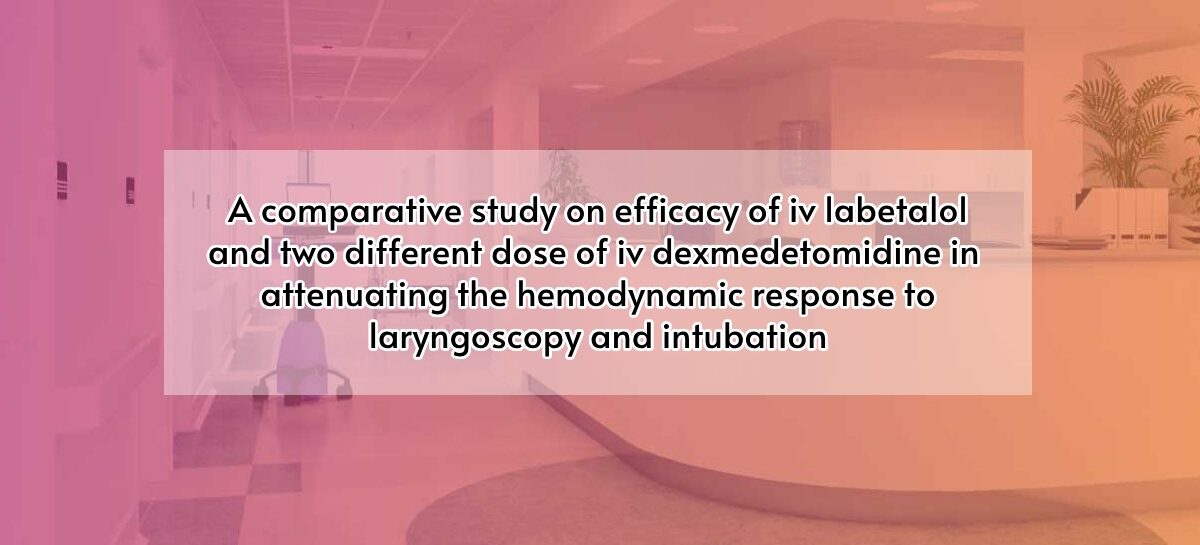INTRODUCTION
- General anaesthesia requires laryngoscopy and tracheal intubation which causes sympathetic surge leading to rise in serum catecholamine levels, causing elevation of blood pressure and heart rate.
- Sympathetic response to laryngoscopy and intubation starts within 5 s, reaches a peak in 1-2 min, and returns to baseline within 5 m. These responses result in increased circulatory catecholamine’s, heart rate (HR), blood pressure, myocardial oxygen demand, and dysrhythmias
- The rise in HR and blood pressure is usually transient, variable, and unpredictable.
- Average increase in HR has been reported to be 23 beats and increase in blood pressure by 53/54 mmHg and decrease in the left ventricular ejection fraction by approximately 20%.
- Although these sympathetic responses following intubation are brief, they still carry grave consequences for high risk patients and may cause arrhythmias, myocardial infarction, cardiac failure, intracerebral haemorrhage and raised intracranial pressures
- Labetalol is a unique antihypertensive adrenergic antagonist having an effect on both selective alpha 1 and non selective beta 1 and beta 2,with rapid onset of action and reaches its peak effect at 5- 15 minutes after iv injection.
- The present study was undertaken to compare efficacy of 0.25 mg/kg of iv labetalol and 0.5 mcg/ kg and 1mcg/ kg of dexmedetomidine iv infusion in attenuating the haemodynamic response to laryngoscopy and intubation.
AIM:
Aim of our study was to compare efficacy of iv labetalol and iv dexmedetomidine in attenuating the hemodynamic response to laryngoscopy and intubation in patients undergoing elective surgery.
PRIMARY OUTCOME:
To compare the efficacy of iv labetalol and iv dexmedetomidine (two different doses).
SECONDARY OUTCOME:
To observe any adverse effects of these two drug in the specified dosage.
PROS AND CONS:
Pros :
- Smooth intubation with stable haemodynamics
- To prevent MI, Arrthymias due to intubation stress.
- Better analgesics and amnestic effects.
- Quicker onset of action
Cons:
- Bradycardia
- Hypotension
- Prolong sedation
- Bronchospasm
REVIEW OF LITERATURE:
Dr. Nagat S El-Shmaa conducted study in 90 people comparing 0.25 mg/kg iv labetalol and 1mcg/kg dexmedetomidine for elective surgeries and studied about the haemodynamic changes, intubation responses were assessed and concluded that dexmedetomidine attenuates the haemodynamic stress response to laryngoscopy and intubation more effectively compared with labetalol without any side effects.
Dr. Singala conducted study of totally 160 patients comparing iv labetalol 0.3 mg/kg and 1 mcg/kg iv dexmedetomidine for laparoscopic elective surgeries concluded that iv dexmedetomidine more suitable than labetalol for maintaining normal haemodynamic parameters in patients predisposed to significant fluctuations in bp or heart rate, especially during period of stress. It also has a relatively lower incidence of side effects.
Michelle gulabani, Pavan Gurha and Nishi kulshreshtha conducted a comparative analysis of lignocaine 1.5 mg/kg and two different doses of iv dexmedetomidine (0.5 mcg/kg and 1 mcg/kg ), 90 adult patients aged 18-65 years of age, ASA 1 and 2 for elective surgeries. The study concluded that dexmedetomidine in a dose of 1mcg/kg effectively attenuates the haemodynamic response to laryngoscopy and endotracheal intubation. Dexmedetomidine 0.5 mcg/kg was effective in blunting tachycardic response to intubation but incompletely attenuated the increase in systolic and DBP. Lignocaine 1.5 mg/kg was more effective than dexmedetomidine 0.5 mcg/kg. finally dexmedetomidine 1mcg/ kg was proved to maintain haemodynamic stability associated with intubation and beneficial for cardiac patients where the stress response to laryngoscopy and intubation was highly desirable.
Dr. Mrunalini patel and team compared the effectiveness of dexmedetomidine versus iv labetalol in attenuation of haemodynamic stress responses of laryngoscopy and intubation and effect of post op sedation.. The study was conducted for 60 patients, posted foe elective surgeries under general anaesthesia taken. The parameters like HR, SBP, DBP, MAP, SPO2 and sedation score were monitored during before and after induction, intubation and 1,3,5 minutes. Concluded that there was a reduction in HR and MAP response to intubation in both dexmedetomidine and labetalol, but dexmedetomidine 1mcg/kg given iv slowly over 10 minutes attenuates the cardiovascular responses to laryngoscopy and intubation in a better manner than labetalol without any deleterious effect. There was statistically significant sedation properties in dexmedetomidine group.



 Dr.B.Varalakshmy
Dr.B.Varalakshmy Dr. Murali Magesh Venugopal
Dr. Murali Magesh Venugopal